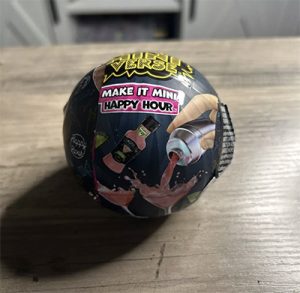
FACTSHEET
By putting toy cocktails in the hands of kids, MGA Miniverse “Happy Hour” model cocktails play reckless games with kids’ lives. By teaching youth that alcohol is a toy, these collectibles threaten to create endless ripples of harm, starting young and lasting well into adulthood.
What are MGA “Happy Hour” Toys?
- Plastic-wrapped, baseball-sized clamshells containing a doll house-sized DIY “cocktail.”
- Balls contain plastic glass, clear resin “drink,” and accoutrements
- Explicitly labeled as cocktails, e.g. “espresso martini,” “blue
Hawaiian,” “lavender gin and tonic” - Shells are opaque and contain randomly selected “cocktail,”
generating a collector incentive akin to Pokemon cards,
baseball cards, or gacha balls - Toys are at the same scale as MGA’s Bratz dolls, encouraging youth to work drinks into
everyday play
 “21+” warnings on wrapping are ineffective, insufficient, and unenforced
“21+” warnings on wrapping are ineffective, insufficient, and unenforced
- Store employees are not trained to card
- Labeling is small and unobtrusive
- Non-21+ Miniverse balls are sold with identical scale and branding
- MGA Miniverse includes dozens of other lines, all of which are plainly meant for kids.
- Branding includes Harry Potter, Lord of the Rings, Hershey’s
- One of the top selling current brands, being awarded “Top Selling Toy” by marketing
research firm Circana - History of negligence—Miniverse products subject to major recall for toxic
components in June 2024
What are the risks from alcohol-themed toys?
- Playing with toys is not just distraction—it’s a form of learning.
- Toy alcoholic beverages directly teach youth that there is nothing wrong with
a child or teenager having fun with a cocktail—establishes a “social norm” - By making alcoholic beverage into a toy, youth start expecting the same
sense of fun from real alcoholic beverages
- Toy alcoholic beverages directly teach youth that there is nothing wrong with
- These toys shape kids’ attitudes just like youth-oriented alcohol marketing.
- Study after study has found that alcohol marketing makes kids more likely to
say they want to drink, and drink excessively once they start - California middle-schoolers who owned alcohol-themed personal items were
3x as likely to have ever drank, and 1.5x as likely to be active drinkers from
real alcoholic beverages
- Study after study has found that alcohol marketing makes kids more likely to
- Kids who start drinking earlier tend to suffer more harms from alcohol.
- Alcohol hurts school performance, trouble with peers, and is associated with criminal justice system involvement
- Risk of sexual assault and violence, including teenage intimate partner violence
- Leading preventable causes of underage death—accidental injuries, homicide, suicide, and over dose—are all heavily influenced by alcohol
- The younger someone starts drinking, the more likely they are to drink excessively as adults
- Kids who start drinking before 15 years old are more than 3x as likely to drink excessively
- Industry targeting of youth is a notorious, well-known tactic.
- Alcohol industry uses tobacco industry playbook—major tobacco companies and major alcohol companies share the same owners
- Tobacco leaders openly admitted that youth sales keep the industry alive
- Toy and candy versions of adult products are sparking kids’ interest in using them
- Kids who start drinking before 15 years old are more than 3x as likely to drink excessively as adults
What can the community do about it?
- Contact retailers and tell them to remove products from shelves.
- Contact manufacturer MGA Entertainment and tell them to pull this product.
- Make sure your kids know: no one should sell them alcohol as a toy.
For more information, please contact Alcohol Justice at advocacy@alcoholjustice.org.

 English
English Spanish
Spanish